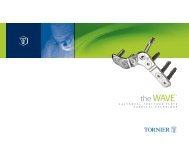Stabilis™ Surgical Technique (PDF) - Tornier DX
Stabilis™ Surgical Technique (PDF) - Tornier DX
Stabilis™ Surgical Technique (PDF) - Tornier DX
Create successful ePaper yourself
Turn your PDF publications into a flip-book with our unique Google optimized e-Paper software.
20<br />
T O r N i E r ® S t a b i l i S a n k l e a r t h r o d e S i S P l a t i n g S y S t e m<br />
Step 19<br />
Position the TTC plate on the bone. Remove any protuberances<br />
that interfere with plate fit. Evaluate plate fit to the tibia. Bend<br />
the plate with the Plate Benders if necessary. It is important<br />
to avoid excessive valgus or varus in the placement of the<br />
TTC plate.<br />
Lateral Tibio-Talo<br />
Calcaneal Plate<br />
<strong>Surgical</strong> Note:<br />
With an arthrodesis of both the ankle and subtalar joint,<br />
excessive varus or valgus is generally poorly tolerated with<br />
ambulation since there is no motion at these joints.<br />
Step 20<br />
Temporarily fix the joint with 2.0 x 150 mm Pins and fit the<br />
Plate to the bone with 2.0 x 150 mm Pins. (Note: it is not<br />
recommended to use two pins in the talar part of the<br />
plate due to the chance of interference with the bone<br />
screw insertions later in the procedure.)<br />
2.0 x 150 mm Pins<br />
Step 21<br />
Attach the Talus Hole Guide loosely to the TTC plate using<br />
the guidepost. The talus is fixed initially followed by the<br />
adjacent calcaneus and tibial bones.<br />
Lateral Talus Hole Guide<br />
Plate Benders




